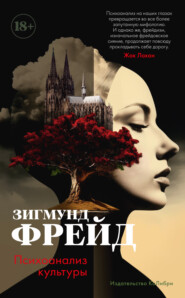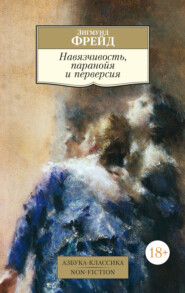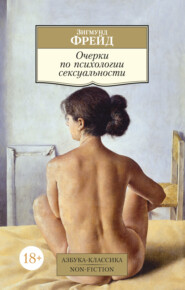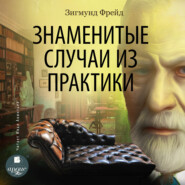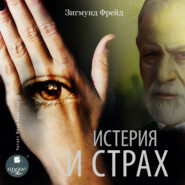По всем вопросам обращайтесь на: info@litportal.ru
(©) 2003-2024.
✖
The Interpretation of Dreams / Толкование сновидений
Настройки чтения
Размер шрифта
Высота строк
Поля
reports new observations on dreams produced in himself. (A number of other attempts produced no results.)
1. He was tickled with a feather on his lips and on the tip of his nose. He dreamed of awful torture, viz. that a mask of pitch was stuck to his face and then forcibly torn off, taking the skin with it.
2. Scissors were sharpened on pincers. He heard bells ringing, then sounds of alarm which took him back to the June days of 1848.
3. Cologne water was put on his nose. He found himself in Cairo in the shop of John Maria Farina. This was followed by mad adventures which he was unable to reproduce.
4. His neck was lightly pinched. He dreamed that a blistering plaster was put on him, and thought of a doctor who treated him in his childhood.
5. A hot iron was brought near his face. He dreamed that chauffeurs[4 - Chauffeurs were bands of robbers in the Vendée who resorted to this form of torture.] broke into the house and forced the occupants to give up their money by sticking their feet into burning coals. The Duchess of Abrantés, whose secretary he imagined himself in the dream, then entered.
6. A drop of water was let fall on his forehead. He imagined himself in Italy perspiring heavily and drinking white wine of Orvieto.
7. When a burning candle was repeatedly focussed on him through red paper, he dreamed of the weather, of heat, and of a storm at sea which he once experienced in the English Channel.
D̕Hervey,
Weygandt,
and others have made other attempts to produce dreams experimentally.
Many have observed the striking skill of the dream in interweaving into its structure sudden impressions from the outer world in such a manner as to present a gradually prepared and initiated catastrophe (Hildebrandt)
. “In former years,” this author relates, “I occasionally made use of an alarm clock in order to wake regularly at a certain hour in the morning. It probably happened hundreds of times that the sound of this instrument fitted into an apparently very long and connected dream, as if the entire dream had been especially designed for it, as if it found in this sound its appropriate and logically indispensable point, its inevitable issue.”
I shall cite three of these alarm-clock dreams for another purpose.
Volkelt (p. 68) relates: “A composer once dreamed that he was teaching school, and was just explaining something to his pupils. He had almost finished when he turned to one of the boys with the question: 'Did you understand me?' The boy cried out like one possessed 'Ya.' Annoyed at this, he reprimanded him for shouting. But now the entire class was screaming 'Orya,̕ then 'Euryo,̕ and finally 'Feueryo.' He was now aroused by an actual alarm of fire in the street.”
Garnier (Traité des Facultés de l̕ Âme, 1865), reported by Radestock,
relates that Napoleon I., while sleeping in a carriage, was awakened from a dream by an explosion which brought back to him the crossing of the Tagliamento and the bombarding of the Austrians, so that he started up crying, “We are undermined!”
The following dream of Maury
has become celebrated. He was sick, and remained in bed; his mother sat beside him. He then dreamed of the reign of terror at the time of the Revolution. He took part in terrible scenes of murder, and finally he himself was summoned before the Tribunal. There he saw Robespierre, Marat, Fouquier-Tinville, and all the sorry heroes of that cruel epoch; he had to give an account of himself, and, after all sort of incidents which did not fix themselves in his memory, he was sentenced to death. Accompanied by an enormous crowd, he was led to the place of execution. He mounted the scaffold, the executioner tied him to the board, it tipped, and the knife of the guillotine fell. He felt his head severed from the trunk, and awakened in terrible anxiety, only to find that the top piece of the bed had fallen down, and had actually struck his cervical vertebra in the same manner as the knife of a guillotine.
This dream gave rise to an interesting discussion introduced by Le Lorrain
and Egger
in the Revue Philosophique. The question was whether, and how, it was possible for the dreamer to crowd together an amount of dream content apparently so large in the short space of time elapsing between the perception of the waking stimulus and the awakening.
Examples of this nature make it appear that the objective stimuli during sleep are the most firmly established of all the dream sources; indeed, it is the only stimulus which plays any part in the layman̕s knowledge. If we ask an educated person, who is, however, unacquainted with the literature of dreams, how dreams originate, he is sure to answer by referring to a case familiar to him in which a dream has been explained after waking by a recognised objective stimulus. Scientific investigation cannot, however, stop here, but is incited to further research by the observation that the stimulus influencing the senses during sleep does not appear in the dream at all in its true form, but is replaced by some other presentation which is in some way related to it. But the relation existing between the stimulus and the result of the dream is, according to Maury,
“une affinité quelconque mais qui n̕est pas unique et exclusive” (p. 72). If we read, e. g., three of Hildebrandt̕s “Alarm Clock Dreams,” we will then have to inquire why the same stimulus evoked so many different results, and why just these results and no others.
(P. 37). “I am taking a walk on a beautiful spring morning. I saunter through the green fields to a neighbouring village, where I see the natives going to church in great numbers, wearing their holiday attire and carrying their hymn-books under their arms. I remember that it is Sunday, and that the morning service will soon begin. I decide to attend it, but as I am somewhat overheated I also decide to cool off in the cemetery surrounding the church. While reading the various epitaphs, I hear the sexton ascend the tower and see the small village bell in the cupola which is about to give signal for the beginning of the devotions. For another short while it hangs motionless, then it begins to swing, and suddenly its notes resound so clearly and penetratingly that my sleep comes to an end. But the sound of bells comes from the alarm clock.”
“A second combination. It is a clear day, the streets are covered with deep snow. I have promised to take part in a sleigh-ride, but have had to wait for some time before it was announced that the sleigh is in front of my house. The preparations for getting into the sleigh are now made. I put on my furs and adjust my muff, and at last I am in my place. But the departure is still delayed, until the reins give the impatient horses the perceptible sign. They start, and the sleigh bells, now forcibly shaken, begin their familiar janizary music with a force that instantly tears the gossamer of my dream. Again it is only the shrill sound of my alarm clock.”
Still a third example. “I see the kitchen-maid walk along the corridor to the dining-room with several dozen plates piled up. The porcelain column in her arms seems to me to be in danger of losing its equilibrium. 'Take care,̕ I exclaim, 'you will drop the whole pile.̕ The usual retort is naturally not wanting – that she is used to such things. Meanwhile I continue to follow her with my worried glance, and behold! at the door-step the fragile dishes fall, tumble, and roll across the floor in hundreds of pieces. But I soon notice that the noise continuing endlessly is not really a rattling but a true ringing, and with this ringing the dreamer now becomes aware that the alarm clock has done its duty.”
The question why the dreaming mind misjudges the nature of the objective sensory stimulus has been answered by Strümpell,
and almost identically by Wundt,
to the effect that the reaction of the mind to the attacking stimuli in sleep is determined by the formation of illusions. A sensory impression is recognised by us and correctly interpreted, i. e. it is classed with the memory group to which it belongs according to all previous experience, if the impression is strong, clear, and long enough, and if we have the necessary time at our disposal for this reflection. If these conditions are not fulfilled, we mistake the objects which give rise to the impression, and on its basis we form an illusion. “If one takes a walk in an open field and perceives indistinctly a distant object, it may happen that he will at first take it for a horse.” On closer inspection the image of a cow resting may obtrude itself, and the presentation may finally resolve itself with certainty into a group of people sitting. The impressions which the mind receives during sleep through outer stimuli are of a similar indistinct nature; they give rise to illusions because the impression evokes a greater or lesser number of memory pictures through which the impression receives its psychic value. In which of the many spheres of memory to be taken into consideration the corresponding pictures are aroused, and which of the possible association connections thereby come into force, this, even according to Strümpell, remains indeterminable, and is left, as it were, to the caprice of the psychic life.
We may here take our choice. We may admit that the laws of the dream formation cannot really be traced any further, and therefore refrain from asking whether or not the interpretation of the illusion evoked by the sensory impression depends upon still other conditions; or we may suppose that the objective sensory stimulus encroaching upon sleep plays only a modest part as a dream source, and that other factors determine the choice of the memory picture to be evoked. Indeed, on carefully examining Maury̕s experimentally produced dreams, which I have purposely reported in detail, one is apt to think that the experiment really explains the origin of only one of the dream elements, and that the rest of the dream content appears in fact too independent, too much determined in detail, to be explained by the one demand, viz. that it must agree with the element experimentally introduced. Indeed one even begins to doubt the illusion theory, and the power of the objective impression to form the dream, when one learns that this impression at times experiences the most peculiar and far-fetched interpretations during the sleeping state. Thus B. M. Simon
tells of a dream in which he saw persons of gigantic stature[5 - Gigantic persons in a dream justify the assumption that it deals with a scene from the dreamer̕s childhood.] seated at a table, and heard distinctly the awful rattling produced by the impact of their jaws while chewing. On waking he heard the clacking of the hoofs of a horse galloping past his window. If the noise of the horse̕s hoofs had recalled ideas from the memory sphere of “Gulliver̕s Travels,” the sojourn with the giants of Brobdingnag and the virtuous horse-creatures – as I should perhaps interpret it without any assistance on the author̕s part – should not the choice of a memory sphere so uncommon for the stimulus have some further illumination from other motives?
II. Internal (Subjective) Sensory Stimuli. – Notwithstanding all objections to the contrary, we must admit that the rôle of the objective sensory stimuli as a producer of dreams has been indisputably established, and if these stimuli seem perhaps insufficient in their nature and frequency to explain all dream pictures, we are then directed to look for other dream sources acting in an analogous manner. I do not know where the idea originated that along with the outer sensory stimuli the inner (subjective) stimuli should also be considered, but as a matter of fact this is done more or less fully in all the more recent descriptions of the etiology of dreams. “An important part is played in dream illusions,” says Wundt
(p. 363), “by those subjective sensations of seeing and hearing which are familiar to us in the waking state as a luminous chaos in the dark field of vision, ringing, buzzing, etc., of the ears, and especially irritation of the retina. This explains the remarkable tendency of the dream to delude the eyes with numbers of similar or identical objects. Thus we see spread before our eyes numberless birds, butterflies, fishes, coloured beads, flowers, etc. Here the luminous dust in the dark field of vision has taken on phantastic figures, and the many luminous points of which it consists are embodied by the dream in as many single pictures, which are looked upon as moving objects owing to the mobility of the luminous chaos. This is also the root of the great fondness of the dream for the most complex animal figures, the multiplicity of forms readily following the form of the subjective light pictures.”
The subjective sensory stimuli as a source of the dream have the obvious advantage that unlike the objective stimuli they are independent of external accidents. They are, so to speak, at the disposal of the explanation as often as it needs them. They are, however, in so far inferior to the objective sensory stimuli that the rôle of dream inciter, which observation and experiment have proven for the latter, can be verified in their case only with difficulty or not at all. The main proof for the dream-inciting power of subjective sensory excitements is offered by the so-called hypnogogic hallucinations, which have been described by John Müller as “phantastic visual manifestations.” They are those very vivid and changeable pictures which occur regularly in many people during the period of falling asleep, and which may remain for awhile even after the eyes have been opened. Maury,
who was considerably troubled by them, subjected them to a thorough study, and maintained that they are related to or rather identical with dream pictures – this has already been asserted by John Müller. Maury states that a certain psychic passivity is necessary for their origin; it requires a relaxation of the tension of attention (p. 59). But in any ordinary disposition a hypnogogic hallucination may be produced by merging for a second into such lethargy, after which one perhaps awakens until this oft-repeated process terminates in sleep. According to Maury, if one awakens shortly thereafter, it is often possible to demonstrate the same pictures in the dream which one has perceived as hypnogogic hallucinations before falling asleep (p. 134). Thus it once happened to Maury with a group of pictures of grotesque figures, with distorted features and strange headdresses, which obtruded themselves upon him with incredible importunity during the period of falling asleep, and which he recalled having dreamed upon awakening. On another occasion, while suffering from hunger, because he kept himself on a rather strict diet, he saw hypnogogically a plate and a hand armed with a fork taking some food from the plate. In his dream he found himself at a table abundantly supplied with food, and heard the rattle made by the diners with their forks. On still another occasion, after falling asleep with irritated and painful eyes, he had the hypnogogic hallucination of seeing microscopically small characters which he was forced to decipher one by one with great exertion; having been awakened from his sleep an hour later, he recalled a dream in which there was an open book with very small letters, which he was obliged to read through with laborious effort.
Just as in the case of these pictures, auditory hallucinations of words, names, etc., may also appear hypnogogically, and then repeat themselves in the dream, like an overture announcing the principal motive of the opera which is to follow.
A more recent observer of hypnogogic hallucinations, G. Trumbull Ladd,
takes the same path pursued by John Müller and Maury. By dint of practice he succeeded in acquiring the faculty of suddenly arousing himself, without opening his eyes, two to five minutes after having gradually fallen asleep, which gave him opportunity to compare the sensations of the retina just vanishing with the dream pictures remaining in his memory. He assures us that an intimate relation between the two can always be recognised, in the sense that the luminous dots and lines of the spontaneous light of the retina produced, so to speak, the sketched outline or scheme for the psychically perceived dream figures. A dream, e. g., in which he saw in front of him clearly printed lines which he read and studied, corresponded to an arrangement of the luminous dots and lines in the retina in parallel lines, or, to express it in his own words: “The clearly printed page, which he was reading in the dream, resolved itself into an object which appeared to his waking perception like part of an actual printed sheet looked at through a little hole in a piece of paper, from too great a distance to be made out distinctly.” Without in any way under-estimating the central part of the phenomenon, Ladd believes that hardly any visual dream occurs in our minds that is not based on material furnished by this inner condition of stimulation in the retina. This is particularly true of dreams occurring shortly after falling asleep in a dark room, while dreams occurring in the morning near the period of awakening receive their stimulation from the objective light penetrating the eye from the lightened room. The shifting and endlessly variable character of the spontaneous luminous excitation of the retina corresponds exactly to the fitful succession of pictures presented to us in our dreams. If we attach any importance to Ladd̕s observations, we cannot underrate the productiveness of this subjective source of excitation for the dream; for visual pictures apparently form the principal constituent of our dreams. The share furnished from the spheres of the other senses, beside the sense of hearing, is more insignificant and inconstant.
III. Internal (Organic) Physical Excitation. – If we are disposed to seek dream sources not outside, but inside, the organism, we must remember that almost all our internal organs, which in their healthy state hardly remind us of their existence, may, in states of excitation – as we call them – or in disease, become for us a source of the most painful sensations, which must be put on an equality with the external excitants of the pain and sensory stimuli. It is on the strength of very old experience that, e. g., Strümpell
declares that “during sleep the mind becomes far more deeply and broadly conscious of its connection with the body than in the waking state, and it is compelled to receive and be influenced by stimulating impressions originating in parts and changes of the body of which it is unconscious in the waking state.” Even Aristotle
declares it quite possible that the dream should draw our attention to incipient morbid conditions which we have not noticed at all in the waking state (owing to the exaggeration given by the dream to the impressions; and some medical authors, who were certainly far from believing in any prophetic power of the dream, have admitted this significance of the dream at least for the foretelling of disease. (Compare M. Simon, p. 31, and many older authors.)
Even in our times there seems to be no lack of authenticated examples of such diagnostic performances on the part of the dream. Thus Tissié
cites from Artigues (Essai sur la Valeur séméiologique des Réves), the history of a woman of forty-three years, who, during several years of apparently perfect health, was troubled with anxiety dreams, and in whom medical examination later disclosed an incipient affection of the heart to which she soon succumbed.
Serious disturbances of the internal organs apparently act as inciters of dreams in a considerable number of persons. Attention is quite generally called to the frequency of anxiety dreams in the diseases of the heart and lungs; indeed this relation of the dream life is placed so conspicuously in the foreground by many authors that I shall here content myself with a mere reference to the literature. (Radestock,
Spitta,
Maury, M. Simon, Tissié.) Tissié even assumes that the diseased organs impress upon the dream content their characteristic features. The dreams of persons suffering from diseases of the heart are generally very brief and terminate in a terrified awakening; the situation of death under terrible circumstances almost always plays a part in their content. Those suffering from diseases of the lungs dream of suffocation, of being crowded, and of flight, and a great many of them are subject to the well-known nightmare, which, by the way, Boerner has succeeded in producing experimentally by lying on the face and closing up the openings of the respiratory organs. In digestive disturbances the dream contains ideas from the sphere of enjoyment and disgust. Finally, the influence of sexual excitement on the dream content is perceptible enough in every one̕s experience, and lends the strongest support to the entire theory of the dream excitation through organic sensation.
Moreover, as we go through the literature of the dream, it becomes quite obvious that some of the authors (Maury,
Weygandt
) have been led to the study of dream problems by the influence of their own pathological state on the content of their dreams.







